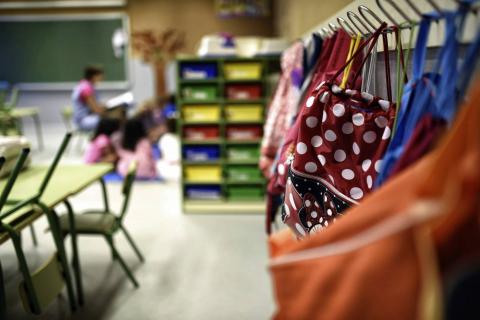Reactions: Academic outcomes of IVF-conceived girls and boys do not differ from those conceived naturally
A study published in the journal PLOS Medicine concludes that the development and academic outcomes of girls and boys conceived with in vitro fertilisation (IVF) are no different from those of children conceived naturally. The analysis is based on data from two national assessments in Australia, including more than 585,000 children born between 2005 and 2014 (more than 11,000 conceived by IVF). The first assessment measured the physical and emotional and cognitive health of children aged 4-6 years; the second focused on the numeracy and verbal skills of schoolchildren aged 7-9 years.

Freepik.
Rita Vassena - FIV resultados académicos EN
Rita Vassena
Co-founder and CEO of Fecundis, a company developing assisted reproduction treatments, and previously scientific director of the Eugin Group
The study is methodologically of very good quality. The authors have taken into account the confounding factors that we know to be associated with fertility treatment and the possibility of better educational outcomes, such as older maternal age, higher socio-economic status or the educational level of the parents. They have applied various epidemiological analysis techniques to control as much as possible for the variability that is intrinsic in a study of this type, where the data have already been collected and therefore it is not possible to go back and find out more than is available. Overall, the number of children born by assisted reproductive techniques is large, over 11,000, and comparisons with controls who have been born without their parents needing to use the clinic is robust.
This study confirms and also extends the information we have on the long-term effects of assisted reproductive technologies. It provides information on the school-age development of IVF-born children and confirms that their educational outcomes at 7 and 9 years of age are indistinguishable from those of spontaneous birth. Furthermore, it indicates that there is no difference between the two forms of conception in the likelihood of a child having a severe developmental disorder, at least at this school age.
As valuable information for health professionals, it should be noted that the cohort of children analysed was born between 2005 and 2014, which means that the results are very relevant to the way we treat infertility today, because in the last 20 years there have been many advances in in vitro fertilisation techniques such as the possibility of culturing embryos for 5-6 days in the laboratory, the possibility of subjecting them to ultra-rapid freezing and the possibility of analysing the genetic content of embryos after "microsurgery" while they are still outside the mother's uterus. There is debate about the impact of these technologies on the peri- and post-natal outcomes of children, so this work contributes greatly to our knowledge and assessment of the long-term risks of assisted reproductive techniques.
It should always be kept in mind that retrospective studies such as this one cannot control for variables that were not collected at the time the data were generated. However, the statistical techniques used in this case mitigate as much as possible the nature of the limitation.
There is one curiosity that remains for me, without being a limitation: the authors of the paper do not differentiate between assisted reproduction techniques, most likely due to a lack of detailed information and the difficulty of knowing and taking into account the effect of all the variables that may be involved in an assisted reproduction treatment (the dose of hormones used, the sperm selection technique, the fertilisation technique, how long the in vitro culture of the embryos has been, etc.) on the results of the school tests. There could, for example, be a relationship between the severity of the infertility diagnosis, and therefore the use of more intrusive techniques, and some of the results observed.
Yolanda Cabello - FIV resultados académicos EN
Yolanda Cabello
Independent clinical embryologist and consultant in assisted reproduction and lecturer on the Master's Degree in Health and Clinical Management at the International University of Valencia
I think the study is well designed, with a sound statistical analysis. In addition, the study includes a very large number of individuals, with well-recorded data and many variables. I would say that it is the study with the largest sample size studying children conceived by ART [Assisted Reproductive Technologies] over time that I have read about. In Spain, the one study we have published in this area is based on 14,119 children conceived by ART, from the embryo health interest group of the Spanish Fertility Society, which focused on malformations in newborns. It concluded that the percentage of malformations observed in children conceived by ART was similar to the rate observed in the overall Spanish population with spontaneous pregnancy.
There have already been studies along the same lines, examining whether there were differences between children born from ART and those who were not. None of these studies has been able to demonstrate important differences due to the technique itself. In most cases, we assume that one or both gametes are damaged due to age or environmental factors and that a couple does not achieve pregnancy spontaneously. This may be the reason for possible complications, rather than the commonly used microinjection technique. Some studies have linked psychological problems [in children] to their father's advanced age, which are not genetically avoidable. In cases of older mothers-to-be or spermatozoa with a high percentage of chromosomal abnormalities, we can perform a screening or pre-implantation genetic diagnosis, so that embryos generated from damaged gametes, which could give rise to a genetically abnormal embryo, can be selected before embryo transfer. This allows us to select only euploid (chromosomally normal) embryos for transfer.
Other factors that could affect the newborn would be multiple pregnancies, but this has long been avoided by selecting only one embryo for transfer at the blastocyst stage, which is the last stage that can be observed in in vitro culture.
In terms of inclusion and exclusion criteria, many factors were taken into account in the study, such as sex at birth, age at screening, language other than English, socio-economic status, maternal age, parity and education.
Limitations of the study included the use of observational data, the possibility of unmeasured confounding, the presence of missing data and the necessary restriction of the cohort to children in school. However, to overcome some of the limitations of observational (non-randomised) data analysis, the authors used a causal inference approach, which attempts to emulate the results of a randomised comparison in a clinical trial.
Amber L. Kennedy et al.
- Research article
- Peer reviewed
- Observational study
- People



